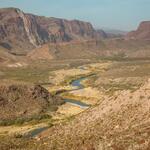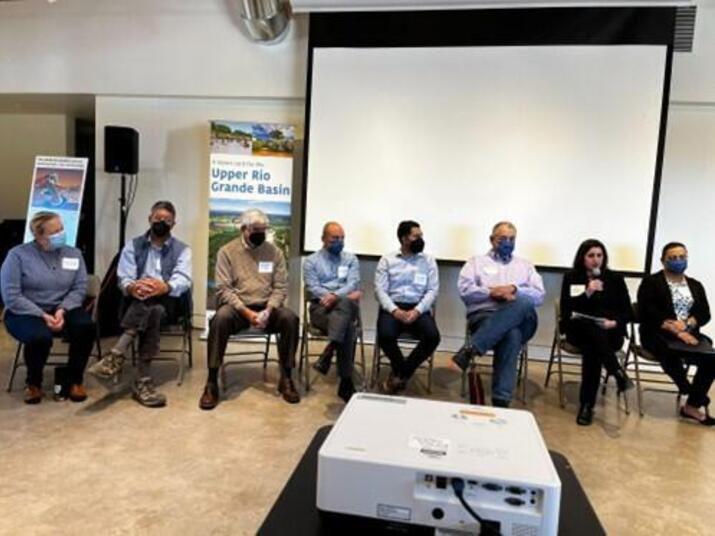- Date: 21 June 2023
- Author: Brian Richter, senior freshwater fellow at World Wildlife Fund
The iconic Rio Grande, or “Great River,” is at risk of losing its greatness. Water overuse and climate change have heavily depleted the once-mighty flow of the river, creating desperate conditions for the farming communities and natural ecosystems that depend on it. We can restore the Rio Grande to some semblance of its former glory, but doing so will require a transformational shift in the way political leaders, farmers and communities perceive the river, their culture, and their livelihoods.
Just how far has the mighty river fallen? Consider this: whereas the river once rose forcefully in springtime in response to melting snows in Colorado, its ‘spring pulse’ has now dwindled to less than a third of its former volume. As a result, water storage reservoirs essential to farming have dried up, leaving farmers without water to grow food and fiber. At the end of last year’s growing season, New Mexico’s largest reservoir, Elephant Butte Reservoir, was less than 10% full.
- Date: 01 June 2023
- Author: Allen Townsend, Senior Program Officer, Freshwater Metrics, WWF
Last week, the Science Based Targets Network (SBTN) launched its highly anticipated first release of science-based targets (SBTs) for nature. Keynoted by Nigel Topping, the High-Level Climate Action Champion for UNFCCC COP26, the launch webinar had over 3,000 registrants from across sectors, including governments, financial institutions, credit rating agencies, media, NGOs, and businesses. WWF has released blogs explaining the relevance of the Targets by Martha Stevenson and Craig Beatty over the past week.
The launch also marks a milestone moment toward addressing the freshwater emergency at scale. Business runs on clean and abundant water. Therefore, companies and their suppliers are a critical part of the solution, and setting meaningful targets is an important step. As part of the initial release, the first version of the freshwater technical guidance reflects decades of science and efforts by the water stewardship community and WWF to promote collective action for restoring freshwater ecosystems and protecting human water security.
- Date: 24 May 2023
- Author: Martha Stevenson, Senior Director of Strategy and Research
Today, the Science Based Targets Network released its first version of nature targets. This is a significant step in uniting the world’s leading companies to stabilize the climate, preserve freshwater resources, regenerate land, secure healthy oceans, and support biodiversity.
We know that business as usual can’t continue. We are exceeding planetary boundaries – the points of no return for nature, climate, and humanity as we know them. You only need to turn to the news to see the devastating effects: wildfires in the boreal, droughts in eastern Brazil, and the empty forests of the Congo, once teeming with biodiversity. These harbingers of what’s to come reflect an ecological system out of balance.
- Date: 22 March 2023
- Author: Tim Rice and Natalie Shahbol
The United Nations 2030 Agenda for Sustainable Development, adopted by all UN member states in 2015, provides a shared blueprint for peace and prosperity for people and the planet, now and into the future. At its heart are the 17 Sustainable Development Goals (SDGs), which recognize that ending poverty and other deprivations must go hand-in-hand with strategies that improve health and education, reduce inequality, and spur economic growth—all while tackling climate change and working to preserve nature.
- Date: 20 March 2023
- Author: Sheila Bonini, Senior Vice President, Private Sector Engagement
It’s not a shocking revelation to say that water is the lifeblood of business. We know that every industry—indeed every company, organization, and person on Earth—needs clean and ample freshwater to survive. It’s such an obvious fact that we take it for granted and forget. For many of us, it’s difficult and frightening to even imagine a world in which we no longer have access to the water we need. Maybe this is why water stewardship never seems to get the attention it deserves. But we no longer have that luxury.
This week, the United Nations hosts the 2023 Water Conference, the first in nearly 50 years. All of us at WWF are thrilled to see water take center stage in a global platform. And I’m personally so excited to see the enthusiastic engagement, participation, and support from so many of the world’s leading companies. The reason for this goes beyond an altruistic notion to save the planet—though of course we admire and encourage that; it’s about making sure their business stays in business.
- Date: 27 February 2023
Water is a vital element of life and one of the world’s most precious resources. However, with risks such as climate change, population growth, and changing consumption patterns, water is under threat. In fact, freshwater species are declining by 83%, faster than terrestrial or marine species. Humans are also at risk, with 1.1 billion people worldwide lacking access to water. By 2025, two-thirds of the world’s population may face water shortages.
Building resilient communities and ecosystems is a crucial step in the fight against the water crisis and climate change, something that the WWF and The Coca-Cola Company partnership is working toward. Across the world, the partnership has identified priority freshwater basins and collaborated with governments, local communities, and other businesses to ensure the long-term protection and sustainable management of freshwater resources. Coca-Cola’s charitable arm, The Coca-Cola Foundation, has also supported work in this area.
One example of this can be found in the partnership’s work along the Yangtze River in China.
- Date: 09 February 2023
As fans from all over the world head to Arizona this weekend for football’s big event, thousands of sustainability professionals won’t be far behind. Greenbiz23 – an annual event for sustainability leaders – kicks off on Tuesday, February 14. Once again, WWF experts from across the organization will lead discussions, provide insights, and connect with like-minded individuals, looking to achieve sustainability solutions at a scale and speed that matters.
If you’re participating in GreenBiz23, we invite you to join an event or session featuring WWF experts and of course come say “hello” during conference networking breaks. Here’s where you can find us:
- Date: 02 February 2023
- Author: Michele Thieme, Deputy Director, Freshwater
After last December’s Convention of Biological Diversity (CBD), just about every aspect of its successes and failures has been dissected and digested at length. But there are two little words from the conference that, weeks later, are still at the forefront of my mind because of the victory they represent. Those words are “inland waters.”
Finally, after years of hard work to raise the profile of inland waters or freshwaters¹ through advocacy with global governments and policymakers, 2022 saw the phrase “inland waters” prominently included in the text of the CBD’s resulting Kunming-Montreal Global Biodiversity Framework.
- Date: 05 December 2022
- Author: Melissa D. Ho, Senior Vice President, Freshwater and Food
Water is essential to life; it flows through all plants, people, and wildlife. We depend on abundant and clean freshwater to drink and flourish, to sustain thriving healthy ecosystems, floodplains, and fisheries, and to grow crops and livestock that feed and nourish humanity. While the Earth is covered in vast amounts of water, we forget or we take for granted that freshwater is a finite and precious resource. Despite the essential role to life and livelihoods, much of our freshwater and the biodiversity it supports are in dire trouble. Only one-third of the world's long rivers remain free-flowing and freshwater species are among the most threatened on the planet; one in three face extinction. The biggest threats and drivers of freshwater degradation are unsustainable agricultural water use, which is causing pollution and overextraction of surface and groundwater resources, and poorly planned infrastructure, which fragments rivers and wetlands and disrupts connectivity and function of ecosystems. All of these challenges are exacerbated by climate change.
- Date: 01 December 2022
- Author: Enrique Prunes
The Upper Rio Grande’s first Basin Health Report Card was launched on Thursday, November 17th. The results, developed by leading ecosystem scientists and local experts to help residents and policymakers better understand the health of their local waters, are mixed: the Upper Rio Grande basin scored a “C.” There is not enough water in this region of the Rio Grande to meet the current needs of all users and sustain a healthy river ecosystem into the future.
The Upper Rio Grande, flowing from headwaters in the Rocky Mountains of Colorado, through New Mexico, and ending in Texas, has supported people and wildlife for thousands of years. More than 6 million people in the United States rely on its resources. Native Nations, Pueblos, and Spanish acequias depend on the river for water, food, and shelter. The river also supports the Chihuahuan Desert, one of the three most biodiverse deserts in the world. As one of the five longest rivers in the US, an American Heritage, and Wild & Scenic River, the Rio Grande’s value as a critical watershed for the people and species of the Southwest region is unmatched.
The launch of the report card was similar to its development – it brought together people from all corners of the region to discuss the status and next steps for water in the basin.
Partnerships prove critical to tackling the world’s water challenges; there is not enough money, time, or resources for any one organization to “solve” the world’s water challenges on its own. The creation of the report card is part of a partnership among Audubon Southwest, University of Massachusetts Amherst, University of Maryland Center for Environmental Science, and World Wildlife Fund and engaged over 100 stakeholders from over 60 organizations. As discussed in the event and throughout the report card’s development, diverse engagement across stakeholders is needed to create a shared vision for protection.
Local Native Nations and Pueblo communities throughout the Upper Rio Grande region are valued members of water rights and management conversations. Engagement with these groups throughout the two-year report card development process was a clear priority, yet it was difficult to fully engage with those groups. Beyond the launch, WWF aims to utilize the report card findings to support advocacy efforts and ensure there are consistent opportunities for engagement and discussion.
This assessment is unique in that it includes existing and new information from across all three states: Colorado, New Mexico, and Texas. Furthermore, it provides regional specificity, highlighting that the indicator scores worsen from north to south. Some indicators may score an A in one locale, but score a C in another. This information allows for location specific management changes to improve on targeted indicators.
““The Rio Grande Basin is unique in its multi-state and binational nature and it makes sense that approaches to dealing with transboundary issues in the basin would be just as unique. This report provides important information for the upper and middle portion of the region and paves the way for discussion and the development of guidance and models that can be applied later along the international reach.” ”
Leslie Grijalva
Environmental Protection Specialist, Environmental Management Division Program Manager Rio Grande Texas Clean Rivers Program, International Boundary and Water Commission, U.S. Section
By convening action at all levels—from local communities to industry to governments—we can usher in a future of cooperation and water security.












